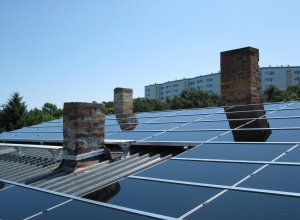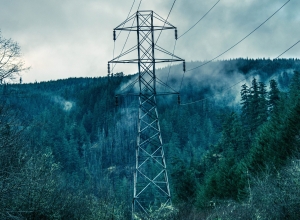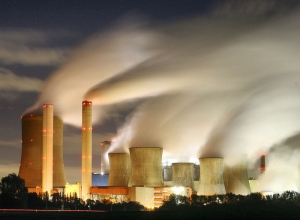What investments in renewable generation and energy storage are needed to drive the decarbonisation of the Swiss residential heating sector ?
Climate change mitigation requires the reduction of greenhouse gas emissions across the whole energy sector beyond electricity. The household sector is of particular interest since energy consumption in households was responsible for 20% and 17% of the CO2 emissions in the European Union [1] and Switzerland [2], respectively, in 2018. Heating represented 80% of the final energy consumption in Swiss households, with space heating and hot water contributing 65% and 15%, respectively. Heat supply in
Heat pumps (HPs) are currently the most promising technology to decarbonise heat supply in the household sector due to both higher thermodynamic efficiency and the possibility of using renewable technologies as an electricity source [4]. In 2017, 18% of the Swiss residential buildings were already using a HP, corresponding to more than 10% of the total heat demand [3]. Importantly, photovoltaic (PV) coupled HP systems can increase the self-sufficiency (also referred to as autarky) and self-consumption (i.e., on-site PV electricity consumption) rates of houses, and therefore become a source of local flexibility [5]. On the other hand, HP integration leads to a higher electricity peak demand [6]. As a result, the expected deployment of HPs (the number of HPs installed per year is expected to double by 2030 in
Why do we need energy storage?
There are various flexibility options which can help to supply renewable energy on demand and minimise the impact of HP operation on electricity grid infrastructure [9]. Among them, energy storage has attracted much attention and interestingly, the capital costs of lithium-ion batteries have decreased by an order of magnitude since 2010 [10].
Energy storage can help to tackle the mismatch between renewable energy supply and demand, and it can play the role of a generator and load depending on the flexibility needs across various physical (e.g., for an individual house and the whole country) and temporal scales (from a few minutes to seasons).
An energy system model to quantify storage needs and investments as a function of heat pump and energy retrofitting
To investigate the role of energy storage in the context of the Swiss energy transition, we developed an open-source energy system model, referred to as "GRIMSEL-AH", which minimises the total system cost (social planner perspective). This work was carried out as part of the "SwissStore" project financed by the Swiss National Science Foundation. The model includes a detailed representation of the Swiss power system and residential heating sector. It distinguishes among four different consumer types, namely residential (both single-family houses (SFH) and multi-family houses (MFH)), service (OCO) and industrial (
We consider three different HP scenarios based on their deployment up to 2050: Market, Fossil and Full. The Full scenario assumes that the whole residential building stock in
Regarding the future heat demand for the household sector, we consider three retrofitting scenarios: Base, 1% p.a. and 2% p.a.The baseline scenario (Base) is defined by taking into account only non-energy related refurbishment and the effect of a warmer future climate, which results in a heat demand of 30.3 TWhth/year by 2050. The other two scenarios include energy retrofitting, considering a yearly rate of 1% and 2% of the building stock. Energy savings driven by retrofitting depend on the building type (single-family or multi-family houses), the urban setting (rural, suburban and urban) and the construction period (separated into decades) based on empirical evidence, ranging from 42-73% of the useful energy demand in 2015 [11]. The resulting annual heat demand is 23.5 TWhth/year and 16.6 TWhth/year by 2050 for the 1% p.a. and 2% p.a. scenarios, respectively.
Retrofitting buildings is prime to reduce investments in the power sector
Based on our HP and retrofitting scenarios, we see that storage technologies (lithium-ion and vanadium redox flow batteries) play an important role to support the massive deployment of HP, e.g., when they cover more than 75% of the residential heat demand (equivalent to 23.5 TWhth/year). Moreover, we notice great synergies between PV and HP deployment, since the coupling of both technologies adds flexibility to the power sector by increasing local PV self-consumption, which results in lower overall energy costs along with a larger PV deployment.
As shown in Figure 1, with an accelerated HP deployment, our different scenario results pinpoint the importance of energy retrofitting of buildings to avoid costly storage investments (especially in suburban areas where the heat demand is the largest). Our results show that a Swiss residential sector which is fully heated by HPs is feasible and, interestingly, energy retrofitting has the largest impact on storage needs. Without energy retrofitting, more than twice the storage is needed compared to scenarios with retrofitting rates between 1-2% p.a.
Figure 1 : Optimal Solar PV (d,e,f), Li-ion battery (LiB) (a,b,c) and Vanadium Redox Flow
Policy recommendations
Based on our results, we set priorities to decarbonise the residential heat demand considering that building energy retrofitting helps to avoid large investments in electricity storage. Decarbonisation plans should first target suburban areas where heat demand is the highest. Once storage needs are reduced with building retrofitting, a combination of storage technologies with both short-term (lithium-ion batteries, 2 hr.) and mid-term (vanadium redox flow batteries, 4 hr.) discharge duration is needed to minimise the energy system costs. Regarding photovoltaic, future policies should first focus on single-family houses (especially in rural areas) which show the highest unexploited photovoltaic capacity potential (for a cost-optimal solution), yet distribution grid costs should be further considered.
[This text is also available in French.]
Complete publication (open access)
Decarbonising heat with optimal PV and storage investments: A detailed sector coupling modelling framework with flexible heat pump operation. Applied Energy, 2021.
doi.org/10.1016/j.apenergy.2020.116110.
References
[1] Greenhouse gas emission statistics – air emissions accounts – statistics explained, 2020. [Online; accessed 30. Jan. 2020].
[2] Office fédéral de l’environnement OFEV. Données: émissions de gaz à effet de serre en suisse, 2020. [Online; accessed 30. Jan. 2020].
[3] Infras; TEP; Prognos. Analyse des schweizerischen Energieverbrauchs 2000-2018 nach Verwendungszwecken, 2019.
[4] Andreas Bloess, Wolf-Peter Schill, and Alexander Zerrahn. Power-to-heat for renewable energy integration: A review of technologies, modeling approaches, and flexibility potentials. Applied Energy, 212:1611-1626, 2018. ISSN 0306-2619. doi.org/10.1016/j.apenergy.2017.12.073.
[5] Alejandro Pena-
[6] David Parra, Stuart A. Norman, Gavin S. Walker, and Mark Gillott. Optimum community energy storage system for demand load shifting. Applied Energy, 174:130-143, 2016. ISSN 0306-2619.
doi.org/10.1016/j.apenergy.2016.04.082.
[7] Ralf Dott. Projekt LEWASEF Warmepumpenheizsysteme mit PV und weiteren Komponenten, 2019.
[8] Ruchi Gupta, Alejandro Pena-Bello, Kai Nino Streicher, Cattia Roduner, David Thöni, Martin Kumar Patel, and David Parra. Spatial analysis of distribution grid capacity and costs to enable massive deployment of PV, electric mobility and electric heating. Applied Energy, 287:116504, 2021. ISSN 0306-2619.
doi.org/10.1016/j.apenergy.2021.116504.
[9] Ecofys. Flexibility options in electricity systems, 2014. Ecofys Consultancy.
[10] A behind the scenes take on lithium-ion battery prices. Bloomberg NEF, 2019. [Online; accessed 4. May 2020].
[11] Kai Nino Streicher, Stefan Mennel, Jonathan Chambers, David Parra, and Martin K.Patel. Cost-effectiveness of large-scale deep energy retrofit packages for residential buildings under different economic assessment approaches. Energy and Buildings, 215:109870, 2020. ISSN 0378-7788. doi.org/10.1016/j.enbuild.2020.109870.
Arthur Rinaldi
Arthur Rinaldi est assistant et doctorant à l'Institut des sciences de l'environnement et au département F.-A. Forel de l'Université de Genève depuis novembre 2017. Il a obtenu son bachelor en HEC en 2012 et a étudié les aspects économiques des éco-constructions comme sujet de sa thèse de bachelor. Il a ensuite entamé des études de physique (bachelor) à l'Université de Genève et a passé son dernier semestre à l'Université de Bologne en 2015. Après avoir obtenu son diplôme de physique (B.Sc.), il a obtenu son Master en sciences de l'environnement (filière Énergie) à l'Université de Genève en 2017 et a réalisé son mémoire de master dans le domaine du stockage de l'électricité pour la production photovoltaïque. Sa thèse de doctorat porte sur les énergies renouvelables et le rôle des technologies de stockage de l'énergie dans le contexte de la transition énergétique suisse.
Martin Soini
Martin Soini a rejoint l'Institut des sciences de l'environnement de l'Université de Genève en janvier 2016 en tant qu'assistant de recherche et a obtenu son doctorat en septembre 2020. Au cours de ses études, il a étudié les interactions entre le stockage de l'énergie et le marché de l'électricité. Avant de rejoindre l'UNIGE, il a obtenu un bachelor en physique à la Technical University of Munich, en Allemagne, suivi d'un master en systèmes énergétiques durables à la Chalmers University of Technology in Gothenburg, en Suède.
Kai Streicher
En octobre 2015, Kai Streicher a rejoint l'Institut des sciences de l'environnement et le Département F.-A. Forel en tant que doctorant et assistant de recherche dans le domaine de l'efficacité énergétique. Dans sa thèse de doctorat, il examine le potentiel technique et économique de la modernisation du parc immobilier résidentiel existant en Suisse. Ses recherches sont fondées sur une approche interdisciplinaire et holistique qui comprend l'analyse des systèmes, le développement de modèles et de bases de données ainsi que la méthodologie du cycle de vie.
Martin Patel
Martin Patel est professeur à l'Université de Genève, où il occupe la chaire en efficience énergétique depuis 2013. Avant sa nomination à Genève, il était professeur assistant et professeur associé à l'Université d'Utrecht (Pays-Bas, 2001-2013), après avoir été doctorant et chercheur au Fraunhofer Institute (ISI) à Karlsruhe (Allemagne, 1993-2000). Ses recherches portent sur les économies d'énergie et la réduction des émissions dans l'industrie et l'environnement bâti, ainsi que sur le stockage de l'énergie.
David Parra
David Parra est maître-assistant à l'Université de Genève. Ses recherches sont interdisciplinaires par nature et intègrent des dimensions techniques, économiques, environnementales et sociales, ces dernières étant actuellement élargies. Il a prouvé sa capacité à diriger des collaborations sur des projets et des publications en Suisse et à l'étranger. Il est chercheur principal du projet Consumer-driven impacts on the grid: Peer effects on the diffusion of technologies and strategies to manage PV electricity and demand (Peer-to-Grid), financé par le FNS.







